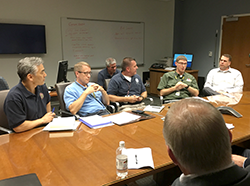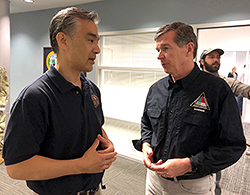Less than two weeks ago, Hurricane Florence churned into the Carolina coast, bringing destructive winds, storm surge, and record-breaking rains. The region is still reeling in the hurricane's aftermath.
Chairman Pai sent us to North Carolina on September 21 to gain a firsthand account of the communications and public safety situation on the ground and to offer the Commission's assistance. Our initial plan was to visit areas hardest hit along the coastal areas between Wilmington, NC and Myrtle Beach, SC. But rapidly changing flood conditions and the unpredictability posed by cresting waterways made travel dangerous. Instead we headed to Raleigh, site of North Carolina's State Emergency Operations Center (SEOC). The SEOC serves as the nerve center for the state's communications emergency response and relief efforts. There we met with key emergency response officials and industry representatives.
North Carolina broadcasters met us at the SEOC to share remarkable stories of perseverance and cooperation from the broadcast community. Broadcasters provided anecdotes of how they worked together, braving harsh winds and severe flooding, to keep stations on the air and bring fuel to one another—all while providing life-saving information to their markets.
We also heard stories about how broadcasters worked to ensure the availability of Spanish language news feeds. And we learned of their efforts to make sure information reached vulnerable populations, such as the deaf and hard-of-hearing community. One broadcaster recounted its employees buying an inflatable boat to ferry supplies to and from their facilities to keep things up and running. Another highlighted a studio full of people sleeping on cots so they could be there 24/7 to provide critical information to viewers and listeners. One broadcaster told us about a partnership with Volvo to enable their advertisers to transport vital supplies to needy communities. We also frequently heard of broadcasters sharing resources such as generators and fuel, sharing spectrum, and sharing news and weather content to ensure their populations had the latest and best information about the hazards they faced. We want to thank Lisa Reynolds, Elizabeth Parker, and Charles Marshall of the North Carolina Association of Broadcasters for making this meeting with us possible.
Next, we met with emergency communications officials from the North Carolina Department of Information Technology (NCDIT), and our partners at the U.S. Department of Homeland Security and FEMA. Pokey Harris, executive director of North Carolina's 911 Board, was at the nerve center of the SEOC—along with Red Grasso, the First Responder Emerging Technologies Director for NCDIT, Greg Hauser, North Carolina's Statewide Interoperability Coordinator, and Eric Boyette, Secretary and State Chief Information Officer for NCDIT. Jarrett Devine from FEMA and Jeremy Johnson from the DHS National Coordinating Center for Communications, both of whom had deployed to the SEOC, also joined us.
The 911 call center at the SEOC facilitated the rerouting of calls from 911 call centers that were compromised by flooding or power outages to other dispatch centers in the state. We were told that this close coordination between 911 call centers and the SEOC made it possible for all 911 calls in the affected areas of North Carolina to be answered during the event—a remarkable feat. The state expects to migrate to Next Generation 911 by 2021. The state also relied heavily on its land mobile radio system called "VIPER" for conducting emergency response. VIPER served as a critical communications link to help coordinate first responders on the ground, as well as to facilitate dispatch to assist those calling 911 for help.
If our brief visit to North Carolina left us with one lasting impression it was this: Communications technologies—whether broadcast, cellular, or wireline—are critical to public safety and emergency response. But even the best of technologies is no substitute for the practical know-how and professionalism of a committed team of emergency first responders who stand ready at all times, and often at personal expense, to do what they do best: to serve and protect. North Carolina's team at the SEOC epitomizes that ideal.

